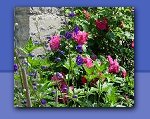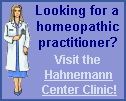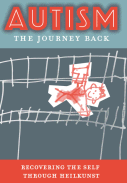

|
FREE Homeopathy at Home, Work and Play downloadable basic study course »  
|
|
Homeopathy: Some Reflections
by Rudi Verspoor FHCH, RHom. March 1998 
Most people who have studied and practiced homeopathy would generally agree on the following:
However, there are several serious misconceptions here:
Hahnemann's Complete Medical System Heilkunst treats disease, not people (although it treats each case as an individual). Each disease is treated depending on its origin, or cause. Heilkunst also allows for the use of allopathic means in emergencies. Heilkunst operates on both of the two main laws of remediation: similars and opposites. Disease is treated depending on its origins (genesis). Different origins will create different dimensions or jurisdictions of treatment. Each jurisdiction operates on certain principles for us to apply the law of similars or opposites. This is not unlike civil law — if a crime has been committed, the prosecutor has to determine the right jurisdiction in which to prosecute. A simple parking fine is not taken to the International Court in The Hague. Similarly, a war crimes case cannot be prosecuted at the municipal level. The person who practices Hahnemann's Heilkunst, the Heilkunstler, must examine each case of disease (crime) by taking down all the relevant information (case-taking) and then determining which jurisdiction is competent to hear the case (principles of cure and healing).
Dimensions of Disease
Each of these is recognised by Hahnemann.
The dimensions of traumas (homogenic), of drug-induced disease (iatrogenic) and of the miasms (pathogenic diseases) are the main ones involved in the treatment of chronic cases that we meet. Most people have multiple diseases involving all of these factors. In approaching such cases, given that Hahnemann stated that we must treat disease, we need to determine what to tackle first and in what order. Fortunately, Hahnemann gives us an order in the section of the Organon dealing with chronic disease. Here he sets out that we must first deal with the blockages to cure of the underlying chronic miasm created by the traumas and the drugs, then approach the miasm. We also have Hering's observations on the natural direction of cure in a disease (from above down for pain, from within outwards and in the same direction of the disease process), as amended by Kent for situations of more than one disease (in the reverse order of the diseases). This tells us that time is a critical factor in determining the sequence of the individual traumas and druggings (we need to treat them in the reverse order of their occurrence, as that is the direction of the natural healing force of the living power or dynamis). In terms of time, the chronic miasms would pre-date the life events, and Hahnemann then gives us the proper sequence of treatment based on clinical experience (Psora first, then Sycosis, then Syphilis). This has been elaborated on by others since for the more recently discovered miasms (Tuberculosis and Cancer).
Principle of Treatment For the homogenic diseases (traumas, both physical and mental/emotional), the principle is one of irritant action, such as Arnica for bruises. The relationship is not related necessarily to the suffering of the patient (symptoms, the pathic side), but to an underlying disease process (the tonic side). In other words, the remedy is a tonic one, not a pathic one. Hahnemann sketches out many of these relationships that are based on a resonance of similarity of irritant action and the homeopathic literature is replete with many others (many related to first aid, but also many that are referred to as 'percentage remedies'). The principle applying at the iatrogenic level was not sketched out clearly by Hahnemann, but clinical experience has revealed that allopathic drug diseases can be cured effectively by tonic remedies made from the drug itself (isodes). This is the principle of resonance of similarity of drug action. For the chronic and acute miasms, the pathogenic level, Hahnemann started the use of nosodes (Psorinum) which was then developed by others such as Hering, Allen and Burnett. Here we have a resonance of similarity of pathogen (represented by the disease discharge). For the treatment of the chronic miasms we have Psorinum, Tuberculinum, Medorrhinum, Carcinosin and Syphilinum. For the acute miasms (or more accurately, for their sequelae) we have the various nosodes such as Morbillinum, Pertussinum, Parotidinum, etc. The issue of the single remedy is a confusing one. It is commonly cited, but little explanation is given as to what it means. Does it literally mean only one remedy at a time? If so, then one could wait only a few seconds and give a second remedy. Does it mean only one remedy so long as the action of the first remedy is still on-going? Hahnemann states that in some cases, the Heilkunstler should not wait until the action of the first remedy has been exhausted. Does it mean one remedy per patient or per disease? Aphorim 273 is often cited as the authority for the "single remedy" tenet of traditional homeopathy. If we look at the passage carefully in the latest translation of Hahnemann's Organon (by Steven Decker), we see that Hahnemann speaks of both the patient and disease. Hahnemann also recognises that a patient could have more than one disease, particularly in chronic cases. Thus, the single remedy per disease allows for the giving of more than one remedy where there is more than one disease. It is interesting that Hahneman (as well as Boenninghausen and others) used two remedies in combination for the treatment of the two sides of disease, as he termed it. It is not clear what two sides he was referring to, but the concept was so enthusiastically received when presented to him by a Dr. Aegidi in 1833 that he proposed adding a special paragraph in the then new 5th edition of the Organon (going to print). He was only dissuaded from so doing out of political considerations. The cases that are presented by Patty Smith follow the sequence laid down by Hahnemann for chronic cases, and the remedies are prescribed on the basis of the principle operating for each disease dimension. Where more than one disease exists at a time, more than one remedy is given. The remedies are based on the tonic side of disease, which treats the underlying disease process, rather than the pathic side which treats more the disease expression. You might be surprised that there are no constitutional remedies used in the case. This is not because we do not use such remedies, but they are not curative of chronic disease. The concept of the constitutional remedy was a construct of Kent and involved taking the totality of symptoms of the patient rather than the individual diseases. This type of "constitutional prescribing" only treats the pathic side of disease (and not the underlying disease process or tonic side). The pathic side is the side involving the suffering of the patient, which is the disease expression. Treatment of this pathic side is not sufficient to remove chronic disease permanently. Kentian constitutional prescribing also confuses pathic prescribing with the treatment of the true constitution, or what Eizayaga calls the genotype. The true constitution is who we are in a state of health and is, thus, based on the principle of health. As such it acts only on the sustentive aspect of the Living Power, what Hahnemann called the Lebens-Erhaltungskraft (which is only involved in maintaining health or healing), not the generative aspect (which is involved in curing), which Hahneman called the Lebens-Erzeugenskraft. Thus, the constitutional remedy can always support health, but never can cure disease. [ Back to Articles ] [ Top of page ] |